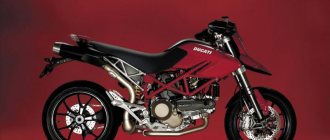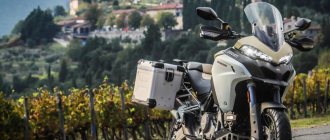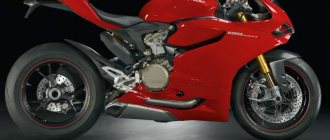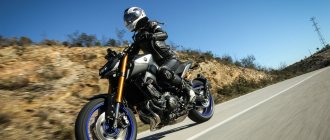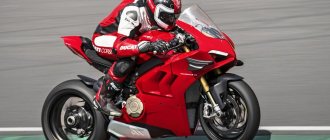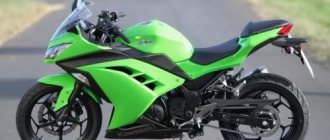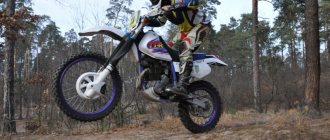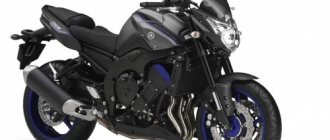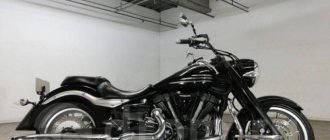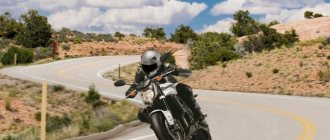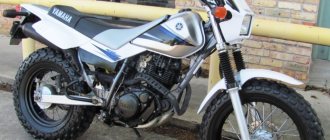Yamaha VMAX 1700 (2009 – present, RUB 700,000–1,400,000)
The second generation VMAX became a legend right when it went on sale. There simply could not be an alternative branch of plot development. The Yamaha VMAX 1700 is a real demon in the guise of a huge, menacing, almost five-minute drag writhing. How the relatively modest Japanese were able to make such a charismatic device is not clear. Even with a discount on a first-generation vintage Vymax already at the waterline.
Engine
It so happens that the configuration of the VMAX engine is dictated by the history of the model. Otherwise, the power unit of the second generation motorcycle was created from scratch. The V-shaped “four” with a cylinder angle of 65° operates with a working volume of 1679 cm3. The filling includes a slipper clutch, forged aluminum pistons, and layer-carburized connecting rods. The engine is controlled via an electronic throttle control along with electronic fuel injection and a variable manifold intake system. The “bottoms” and “tops” of the engine are scrappy. The final performance characteristics are fantastic - 200 hp. With. at 8500 rpm and torque at 166.8 Nm at 6500 rpm. And this is on a factory motorcycle! There are features. In Russian realities, such a technologically advanced engine can only properly digest 98-grade gasoline. On the 95th and even more so on the 92nd it gets very hot and is unstable. Forget about economy! Models manufactured before 2012 have a known problem with the oil pump. Any dealer willingly fixed it and continues to fix it free of charge under warranty. “Cured” motorcycles are distinguished by a stamped asterisk at the very end of the VIN number on the engine.
Transmission
The five-speed gearbox is the pinnacle of reliability. The same can be said about the rear wheel cardan drive assembly with gearbox (loss rate is only 12%). And this despite the notoriety of similar units of the former “Sledgehammer”.
Frame and body kit
The powerful diagonal aluminum frame at the bottom is closed to the engine. Everything would be fine, but there is one “but”... the theoretical lightness and delicacy of the design is completely killed by the thick metal subframe that supports the engine in front. The body kit is aesthetically and qualitatively made at the highest level. In falls, the exhaust system and the gills of the false air intakes often get damaged.
Brakes
Six-piston calipers from Yamaha YZF - R 1 and 320 mm discs are an argument for anyone, but not for the VMAX rushing at full throttle. Electronic assistants and specifically the anti-lock braking system in this case are important and very much in demand!
Pendants
A fully adjustable fork with a pipe diameter of as much as 52 mm (the diameter of the cups is all 70 mm), a rigid, fully adjustable monoshock absorber, 18-inch wheels with low-profile tires - this is immediately and wholesale found only in the VMAX 1700. The chassis works confidently, but strictly until the moment when the driver begins to imagine himself as a famous motorcycle racer.
Comfort
Comfort while driving a “Sledgehammer” is not a conditional thing. The driver's body is still slightly tilted forward, towards the tachometer saucer on the steering wheel, which does not exclude convenience during a short trip. On the track the motorcycle stands extremely confidently and there is no reason to bother the crew.
Modifications
In 2015, to mark the 30th anniversary of its release, Yamaha released the VMAX Carbon anniversary series with a carbon fiber body kit and an Akrapovic “can.” In Japan and some European countries, in particular within the market of Vymax-fan France, 1700 motorcycles are strangled with 200 hp. With. up to 106 l. With. The 2021 model features LED turn signals and taillights, an OLED instrument panel and new colors, including yellow and black to celebrate Yamaha's 60th anniversary.
The first “childhood delights” of owning a motorcycle are far behind us; it’s time to sum up the results of the second season. 18 thousand have been passed, there is something to talk about and something to complain about. Although the motorcycle is certainly good. UPD: the review after the 1st season is here. In this review I will only talk about new impressions.
18 thousand have been passed, there is something to talk about and something to complain about. Although the motorcycle is certainly good. UPD: the review after the 1st season is here. In this review I will only talk about new impressions.
Briefly
Pros: + Not bad (for a cruiser) versatility of use + Dynamics + Handling + Appearance + Brakes + Humane fuel consumption Cons: - 6th gear is missing - Ergonomics in long-distance driving are lame - Carrying luggage is not ideal - Complete absence of mechanical aftermarket (body kit not included) account) - Confused (by chopper standards) device and maintenance
Flaws
I'll start with them, it's better to leave the good for last.
1. They say that every motorcyclist on the highway needs one more gear. I can’t speak for everyone, but on Warrior the 6th is clearly asking for it. Objectively, the Warrior’s gearbox is good, the closely spaced gear ratios are AWESOME! But at speeds above 130, another step is requested. And it’s not just that after 4000 rpm the engine starts to turn sour. What’s more important is that: — After 3500 there are childish vibrations that you can’t drive with for long. — Consumption at 150 km/h rises from 6 to 7 liters, which begins to depress with a 15-liter tank
I couldn’t find any relatives for my model (which is logical) or even an aftermarket. In general, no one seems to produce aftermarket mechanics for Japanese cruisers - an obvious competitive advantage of Harley, for which many different companies make engines, gearboxes, and much more mechanical stuff. Just for fun, I looked at other Yamaha models: - all choppers - 5 steps - V-Max (both old and new) - also 5 steps - even the FJR1300, seemingly a sport-tourer - again 5 steps. Just some kind of conspiracy. I looked at the rest of the Japanese, almost all cruisers again have a 5-speed gear. An uncharacteristic exception was the Kawasaki VN1700, suddenly 6 steps! If it weren’t for the dead engine (73 hp) and the generally “crappy” design, I would have taken a closer look at it... But HD and Victory have been producing cruisers with 6 speeds for several years now.
My first thought was to play with the gear ratios using the driven/driven belt in order to reduce the operating speed at the same speed. The operation is quite real, certain Harley pulleys are installed, the belt is changed and, in principle, that’s all. However, acceleration becomes more “vegetable”, which is not at all cool in the city. Or it may be ice, but then there may still be a problem with reconfiguring the speedometer.
But if you change gear ratios, would it be nice to invigorate the engine? That was the second thought. A couple of years after the model was launched on the market, Yamaha began selling Speedstar series parts. The power increased from 86 to 104 hp, I don’t remember the torque numbers. As of now, it is impossible to assemble the kit completely; apparently, it is no longer produced. In theory, you can use the engine from the MT-01, they are the same in size, and the um-te-shka is still in production. But in practice, the amount of work required for this +4hp. and +15Nm still needs to be studied...
Diagnosis: almost no cure. Trying to fit an American engine and a 6-mortar into the frame is a direct path to welding/grinder. Then it’s easier to make a custom from scratch.
2. The canons of the class dictate the features of landing and ergonomics in general. Due to the far-out footpegs, the entire body weight falls on the 5th point, thanks to the fact that at least the saddle is wide and you can change your seating position a little while riding. The “stick” steering wheel, although not original, still forces you to reach forward and almost climb onto the tank. Handling in the city is good, but on the road you get tired quickly: - 5-6 hours on the road are not stressful at all, you can stop only when necessary to refuel - after 700 km you still have strength, but along the way you want to stop more often - 1000 km is a conditional limit, when more or less normal, but it’s better not to go further in one sitting - after a thousand, fatigue grows non-linearly, 1200 is basically passed (checked three times), but 1500 - a “motorcycle overdose” sets in, when all parts of the body try to fall off and you don’t want to look at the motorcycle a couple more days.
Red zone: fatigue after 700 km (right leg, collarbone), yellow - after 1100 km (5th point, lower back, arms, neck)
Once again about vibrations. They are transmitted especially strongly to the running boards (I ride in sports plastic boots, so the shoes do not extinguish them), and after a long road they also radiate to the 5th point. Perhaps it can be treated by installing arches with extensions, but you have to try. The arcs must be installed in any case, the question is where: the most obvious place for the upper fasteners is the starter bolts, which is not good and what I already ran into with the old arcs (they fell off after a couple of incidents). If you drive for a long time, then in addition to this, your right leg will go numb, due to the protruding side air filter, and your arms will go numb due to the not quite straight landing.
Diagnosis: treated by replacing the steering wheel, possibly the saddle, stems, and windshield. But the problem will not disappear 100%.
3. The mileage on a tank “dry”, if you save fuel, in theory no more than 250 km, the maximum reached 230 (not from a good life), I prefer to refuel after 150-200 km. On a long journey or in cold weather, you have to stop every 100-120 km, due to fatigue and poor wind protection. I don’t know if there are higher windshields, but something definitely needs to be decided - I’m tired of depending on the weather, and depending heavily. The same applies to heated grips.
Specific ergonomics and a small tank affect the average speed on the highway. According to the stories on the BP, an average of 90 km/h over 1000 km of travel is considered quite normal speed even for cruisers. I only managed to do the average 100 once (Voronezh-Moscow, only 500 km), for 1000 km or more the average did not rise above 75. Despite the fact that most of the road I was driving 120-150.
Diagnosis: a new tank is needed, at least 20 liters.
4. There are also complaints about the transportation of luggage. Firstly, you can’t carry heavy loads on the trunk; this will deform the wing (although maybe this is for all cruisers?) Secondly, I still haven’t been able to find normal-looking panniers (or Corbin’s plastic ones for $2000-3000 for set). For the coming season, I’m thinking of taking some simple textile side skirts, so as not to fool my head, it’s cheap and cheerful.
The deformation zone of the rear wing is highlighted in red.
In the 2012 season, I dealt with luggage extremely simply: I placed a large backpack with a heavy load on the back seat, a smaller and lighter backpack on the trunk (after I discovered deformations of the rear fender), wrapped it all in conditionally waterproof covers and tied it with spiders behind passenger backrest and trunk. It held tightly and fit well. It didn’t affect the handling at all, despite the fact that the central trunk, even on the Electric Train, seems to add hemorrhoids when driving.
5. I think I already wrote about the “convenience” of maintenance (in comparison, even the ergonomics are ideal!). Although most of the work is done with standard tools included in the 100+ element set, strong and flexible fingers still do not hurt. So, we have the following: — two air filter housings (two!!!11), to replace the filters you need to remove the tank; — removing and putting the tank in place must be done by two people; long strong fingers and a good eye are required, otherwise the pipes will not fit where they need to be; — to replace the spark plugs, you need to remove the upper air filter housing, the procedure is extremely frustrating: very dense laying of wires and other various hoses at the work site, plus it’s difficult to put rubber bands on the intake pipes when you’re not used to it. If you have a cardan spark plug, you can do without this, but the manual says to do it by removing the filter. It may be easier to adjust the tightening force this way;
Excerpt from the service manual: dismantling the upper air filter housing. Happy spark plug replacement, %BIKERNAME%!
— Of the 4 spark plugs, only two can be easily replaced, and one, the right one in the front cylinder, has to be changed by touch (or remove the steering wheel with the instrument panel, but this is beyond common sense); — with long forward flows, any operations on the rear axle (checking the belt tension, changing tires or, God forbid, replacing the belt) lead to the need to disconnect the exhaust, because the pipes overlap the axle. The stock exhaust does not cause such problems; — the belt, as it should be, is difficult to change; this requires removing not only the wheel, but also the pendulum. By the way, I have only seen tire belts (if the main one is broken) for Harleys, and then not for everyone. You cannot take a spare regular belt on long-distance trips (because it cannot be twisted, crushed, etc.). + but the oil filter is located very conveniently; installation/disassembly is perfectly accomplished using the most common chain wrench for oil filters costing 100 rubles. maximum.
6. Headlights and turn signals. The head light is not enough for driving at night. There is a lot of plastic around the rear turn signals, it is wrong and unaesthetic. Methods of treatment: a correctly selected chandelier or the right xenon, an integrated stopper (already purchased), at the same time it will be possible to replace the non-pont plastic shovel that mounts the license plate with a “boyish” metal platform with a mount on the rear axle.
About pleasant things
If such shortcomings have not yet confused you, read on...
The device is quite suitable for driving through traffic jams on Moscow highways (TTK, MKAD, wide radial highways), especially with the arches removed - you can make sharper maneuvers between cars. Long-range use is clearly no worse than road work, you drive slower, but you get tired slower and you can drive longer in one sitting. You can carry a lot of luggage without affecting handling.
Dynamics up to 100 km/h allows you to misbehave in traffic, up to 140 you can confidently overtake, but then the lower engine “deflates” and the vibrations get annoying. But driving at 120-130 is the most fun. Lack of hp and I rarely feel the moment, mainly when overtaking long lines of trucks on 1-lane roads.
Handling, braking: no complaints, although there is almost nothing to compare with. The rear brake performs very well; it is convenient to slow down on the highway. Only once during the season did I have to brake completely on my ears, on a wet road. The motorcycle skidded heavily left and right, but managed to stop before the truck. I was almost sure that I would fall, but it turned out okay, I just had to not disturb him. Along serpentines, the speed of movement depends on the intensity of the flow and how scared you are. Once we were riding through the mountains in a convoy with “neat” sports, I was not a burden. The softness of the suspension is comparable to the average settings of the R1200GS, and it absorbs bumps no worse. A hole in a turn remains just a hole, and not the beginning of “twisting” of the frame and not a struggle for the stability of the motorcycle. The only time my spine went into my underpants was on a really bad road surface and at high speed; this only happened at night on an unlit road.
The appearance still does not leave me indifferent, partly due to the body kit. In stock, especially with the original exhaust, the motorcycle doesn’t look nearly as interesting. By the way, the “wow factor” of choppers seems to grow as you move north - in the south almost everyone is “stick” to sports, in Moscow it’s 50/50, in Karelia they paid me much more attention 
Reliability. It’s worth banging your head against the wall, but I will do the “big” maintenance, with checking all the hoses, wiring, etc., only now, after 26 thousand miles. Until this time, I simply changed consumables according to the regulations; the only unscheduled change was the belt change after 49 thousand, which suddenly broke. At the end of the 2012 season, the motorcycle clearly decided to remind us of this, when first the clutch cable flew, then the powerful negative terminal of the main harness immediately broke, and before putting it in the garage, it generally refused to start with an incomprehensible crackling sound from the battery area (relay?..). In general, despite the hassle of maintenance, there are no complaints about reliability.
Ideal motorcycle
The description of the shortcomings took up much more space than the positive part.
Probably, I’m just being too picky; after all, more than half of my current mileage has accumulated on long-distance trips. What ideally I would like to see from my motorcycle: 1. Comfortable fit for the city and the highway 2. Good wind protection 3. Directional stability 4. Soft suspension without loss of control 5. Acceptable “anti-stacking” 6. Good brakes and dynamics (confident 150 highway, fast acceleration 70-150) 7. Stress-free transportation of 20..40 kg of luggage 8. Easy maintenance 9. A large number of aftermarket spare parts, both body kit and mechanics 10. Mileage on a tank of at least 300 km 11. Reliability 12. Appearance 13. The feeling of STUPID in the engine and the reserve of traction under the right hand from the very bottom. My device satisfies the stated criteria at least half, and if we take into account the last point, then even more . Am I ready to change it to something else, even with an unlimited budget - The question is open, because I have too little experience riding other motorcycles, just ride and ride. So far, I’m probably only ready to consider 2 other devices as my main motorcycle: 1. KTM Adventure 990R. Not a chopper of course, but V2 and everything else is great! 2. HD Road King. Harley and Trub in general, I wonder what it's like in a long distance. I'm captivated by the abundance of the aftermarket, scared away by the price, and for now it's a “pig in a poke” for me. Besides, remembering OcM’s story about a trip across America, it’s not a fact that Roadking will be so much better as to warrant buying it. Again, you have to travel. 3. UPD: (thanks to ZloYa) Victory Cross Country. According to many recent tests, the best, or one of the best baggers.
. Am I ready to change it to something else, even with an unlimited budget - The question is open, because I have too little experience riding other motorcycles, just ride and ride. So far, I’m probably only ready to consider 2 other devices as my main motorcycle: 1. KTM Adventure 990R. Not a chopper of course, but V2 and everything else is great! 2. HD Road King. Harley and Trub in general, I wonder what it's like in a long distance. I'm captivated by the abundance of the aftermarket, scared away by the price, and for now it's a “pig in a poke” for me. Besides, remembering OcM’s story about a trip across America, it’s not a fact that Roadking will be so much better as to warrant buying it. Again, you have to travel. 3. UPD: (thanks to ZloYa) Victory Cross Country. According to many recent tests, the best, or one of the best baggers.
In general, common sense is trying to tell me that cruisers are not particularly suitable for long-distance travel - they are just a little better than road bikes, and that humanity has come up with many other classes for such use: tourenduros, sport tourers, luxury tourers.
But I don’t want to exchange metal for plastic, the rough character of the V2 for a “refined” in-line or boxer, the bestial roar of large cylinders for the “sewing machine” of a riding motor. So I fully admit that it would be best to greatly alter your Warrior, or make a custom one based on its frame and chassis. They are too good for him
They are too good for him
Ducati XDiavel (2016 – present, RUB 1,100,000–1,400,000)
By changing the locations of the controls, the Ducati Diavel concept takes on a radically different meaning. XDiavel is a new word in the history of Italian motorcycles.
Engine
XDiavel is a child of modern technology. He was lucky with the power unit. On board is a 1262 cc L-shaped eight-valve Dual Spark twin Testastretta DVT (like the new Multistrada 1200) with variable valve timing, electronic fuel injection, liquid cooling and electronically controlled throttle. Electronic assistants include a system for changing ignition maps, traction control, cruise control, as well as Ducati Power Launch (DPL) launch control for a quick start from a traffic light.
In terms of reliability, despite the complexity of the design, this power unit with a service interval of 15,000 km and a desmoservice interval of 30,000 km is an undoubted step forward. The only thing the XDiavel engine doesn’t like is low-quality fuels and lubricants. Only the best gasoline and oil!
Transmission
The roller chain as a drive mechanism has not proven itself very successfully on the base Diavel. In the case of the XDiavel, the engineers decided to introduce a belt drive. Here we can see the focus on the American market. The motorcycle is devoid of jerks at the start and extraneous noise in the drive. The six-speed gearbox is smooth and provides excellent feedback.
Frame and body kit
There is no frame as such. There are two sections. One at the front, in the form of a complex tubular cage, is held directly by the cylinders, acting as the main frame. The second, in the form of aluminum castings, serves as a subframe, holding the tail section of the motorcycle. In fact, the maximum functions of the frame are transferred to the motorcycle engine. The body kit is minimalistic. Plastic is present only in the area of the tank, tail and motor. This ensures that the engine and the stunning rear cantilever wheel are always visible. Despite the aesthetic thoughtfulness, such a dense and openwork layout does not withstand falls and accidents.
Brakes
Ducati has long been associated with Brembo. XDiavel is proof of this. Two 320 mm diameter discs with radially mounted four-piston Brembo M 4-32 calipers (M50 for XDiavel S), as well as one 265 mm disc with two-piston Brembo, together with a powerful ABS, provide the motorcycle with truly powerful braking. The heavy XDiavel slows down almost like a modern sportbike.
Pendants
The Ducati XDiavel and XDiavel S are equipped with an adjustable 50mm inverted fork and an adjustable monoshock, which is supported by an aluminum birdcage-style single-sided swingarm. The rear tire has a serious width of 240 mm. The suspensions are designed for high-quality asphalt. On Russian potholes, the crew, and especially the passenger, will have a hard time.
Comfort
The driver is no longer so actively involved in steering. He sits relaxed in the low-slung seat and points his feet forward toward the front wheel. The slight tilt of the body is dictated by the compact steering wheel. Long cruises are not an end in itself for the XDiavel, but it is ready for weekend trips and promenades around the city.
Modifications
In the relatively short production period, XDiavel did not have time to acquire image and other special versions. The exception is the top modification XDiavel S (LED optics, different wheels, Brembo M 50, stylistic improvements).
Test drive: 200-horsepower Yamaha V-Max 2009 - holds its own!
Test Drive
| Tweet |
V-MaxYamahamotorcyclesneikidtest drive
Officially, the legendary V-Max model of 2009 was presented by the Japanese concern Yamaha in June last year, but real deliveries began only in November, so the impressive appearance of this muscular handsome man attracts attention on the capital's streets both day and evening.
The motorcycle has a completely new 4-stroke, 4-valve, 4-cylinder V4 engine with a capacity of 1679 cc. This power unit produces a maximum power of 147.2 kW (200 hp) – at 9,000 rpm. Maximum torque – 166.8 Nm at 6,500 rpm. The new engine is 40% larger in volume than its predecessor, which powered the previous V-Max. Therefore, the owner is guaranteed a thrill.
The cylinder diameter of the brutal V-Max is 90mm, piston stroke is 66mm. Compression ratio – 11.3 to 1. Electric starter, five-speed gearbox. Curb weight of the 2009 V-Max is 310 kg. Tank – 15 liters. By the way, the peculiarity of the V-Max tank is that there is a display on the tank, which displays information about the amount of fuel, the selected speed, time... To fill the motorcycle with fuel, using the lever located under the saddle, you need to open the back of the driver's seat, where the tank neck is hidden. The motorcycle is equipped with hydraulic ABS to prevent wheel locking during heavy braking.
The motorcycle has a low-profile aluminum frame and six-piston radial front brakes. Front suspension – telescopic forks with a diameter of 52mm. The rear one is a pendulum. Suspension travel is 120mm at the front and 110mm at the rear. Tires – 120/70 R18 front and 200/50 R18 rear. Dimensions (length, width, height) – 2395x820x1190mm. Seat height – 775mm. Wheelbase – 1700mm. Ground clearance – 140mm.
Unfortunately, an accident occurred during the motorcycle test, so the presented photographic materials can rather be regarded as operational. As a result of a collision with a car, a heavy (310 kg) Yamaha V-Max motorcycle survived and did not fall...
The offender is another road user; a car traveling in the next lane decided to change lanes from the right to the far left lane, crossing solid lanes and not turning on the turn signal, and appeared sideways in the path of the V-Max. It was not possible to avoid the impact to the right or left, since in the left lane there were cars waiting for the traffic light signal to turn around, and there was traffic on the right. The impact threw the motorcycle into oncoming traffic, but while maintaining stability, we managed to stop the V-Max, returning to the median. As a result of the accident, the driver of the car was not injured, the pilot of the motorcycle escaped with slight fear and a hematoma of his right leg, the Yamaha V-Max motorcycle was safe and sound. It should be noted that Dainese equipment protected me from leg fractures.
Among the advantages of the new model, I would like to note a comfortable pilot’s seat, good handling and, of course, stability! When driving at low speeds, the pilot will probably need a little effort when taxiing; when driving fast, the bike becomes especially obedient. And remember that you need to be careful when unscrewing the throttle of this beauty, because two hundred horses is... a lot!
Motonews.ru expresses gratitude to the official representative of Yamaha Motor Co., for assistance in conducting the test drive. We would also like to thank everyone who witnessed the accident and stopped to offer assistance. I would like to note that biker solidarity is truly felt in the capital, and this is very pleasing!
Let us remind you that the prototype of this bike was first shown at the 2005 Tokyo Motor Show. Since then, the world has stood still in tense anticipation. Then the new generation V-Max appeared at several more international exhibitions. And finally, the long-awaited final premiere!
The first V-Max was released by Yamaha back in 1985. This bike was original in every way. Everything about this bike was 100% Japanese, from the first sketches and drawings to the finished machine. And this despite the fact that the motorcycle was originally intended for the American market. The motorcycle was equipped with a 1200 cc engine, which could compete with giant American motorcycle engines. The goal was to achieve high torque, high power and impressive acceleration. That is, get everything at once. From the V4 engine, which usually produced 90 hp, they were able to squeeze out as much as 145 for the V-Max! Power was also increased by the highly advanced V-Boost system, which allowed the carburetors to feed fuel to each individual cylinder after 6,000 rpm through servo-controlled throttle bodies.
The first V-Max also featured unique handling. In 1985, this essentially road bike gave sports bikes a head start when cornering! And on straight sections, for several years after its release, not a single sports bike, let alone a road bike, could compete with the V-Max in terms of speed. The engine performance was reminiscent of large V8 engines. All you had to do was open the throttle and the motorcycle, under the control of a brave pilot, turned into a dot.
Photo: Motonews.ru, Yamaha
| Tweet |
In order to leave a comment, you must log in or register!
Comments
More comments
Tire selection
Both motorcycles have unique tire sizes designed and manufactured specifically for them. For what? I don’t know, because it was possible to get by with full-time ones to make life easier for the owners, but the engineers did not want to take the easy route.
On the VMax, both wheels have an 18” bore diameter (the R18 at the end is the diameter, not the radius). And if the front is the same as on the Honda ST1300 and Yamaha Warrior, and there are no problems finding it, then the rear in size 200/50ZR18 is a unique thing. The standard size is produced by Bridgestone, which was supplied to the assembly line. You can also find Metzeler Marathon, which is a good alternative. Due to the fact that there is traditionally a problem with Bridgestone in Russia, the choice of expensive famous tires comes down to just one brand – Metzeler. Interestingly, when installing a wide rear disc and moving to the 240/40-18 size, the choice appears. If you are not brand-sensitive, you can install Korean Shinko 011 Verge tires both forward and backward. These are sports touring tires with good grip, which look modern and compare favorably in price to Metzler.
The front on the X Diavel is industry standard 120/70ZR17. You can choose either slicks or off-road. The difficulty is again with the rear wheel. 240/45ZR17 is a unique size and is not used in any motorcycle except the Diavel. Surprisingly, the stock Pirelli Diablo Rosso II went on sale at the same time as the Diavel and was always available in Moscow. Later, Michelins were added in this size. First Pilot Power 3, later Power RS. The stock Pirelli is universal, the Power3 lasts longer, but holds up worse, the Power RS has excellent grip properties and is comparable in service life to the Rosso II. I would look in his direction when choosing.
www.motorezina.ru
Reading lesson > February 26, 2021 08:06 Mikhail Pimus
